冀教版八年级上册英语教案 Unit 1 第2课时
- 格式:doc
- 大小:49.00 KB
- 文档页数:4
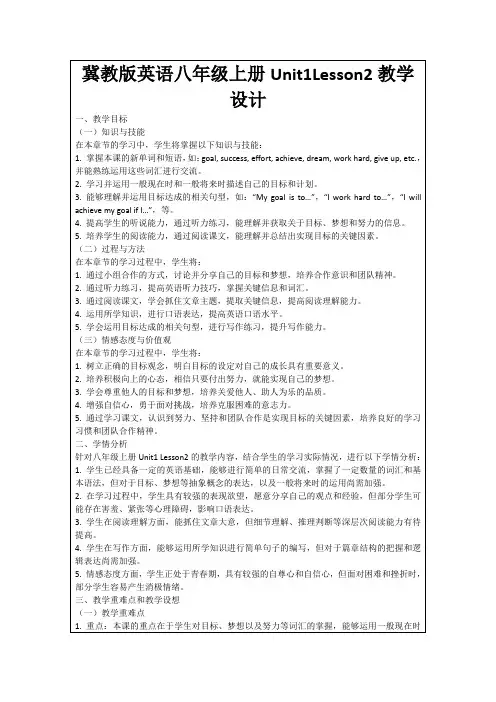
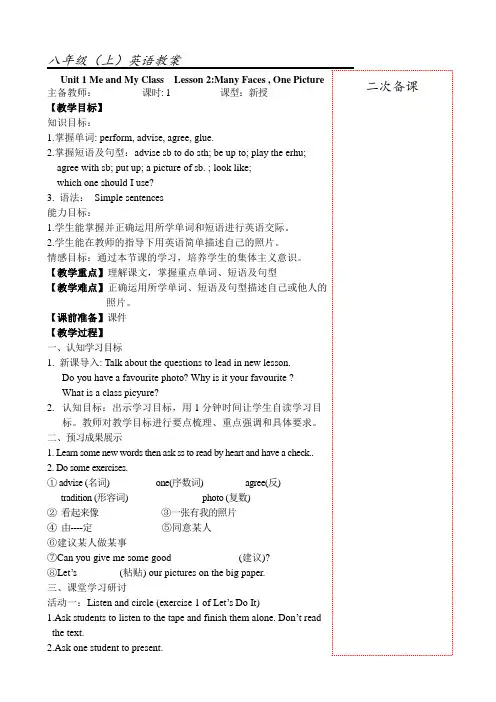
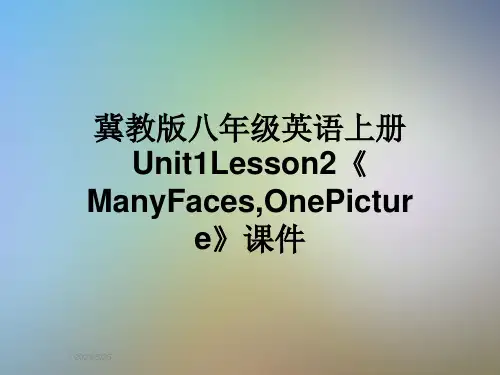
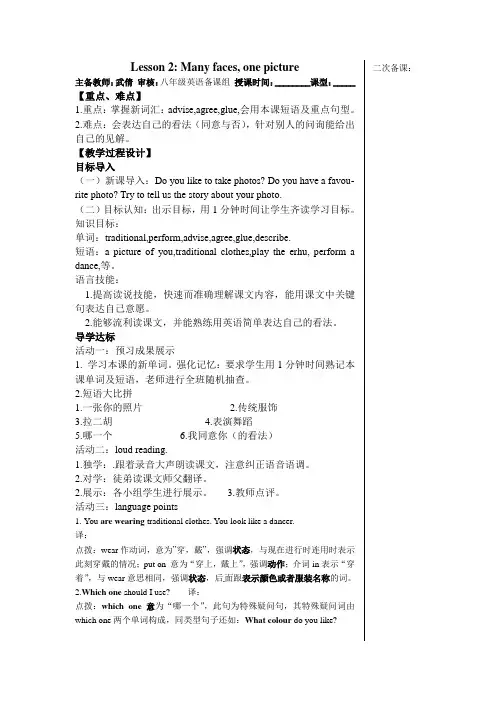
Lesson 2: Many faces, one picture二次备课:主备教师:武倩审核:八年级英语备课组授课时间:________课型:_____【重点、难点】1.重点:掌握新词汇:advise,agree,glue,会用本课短语及重点句型。
2.难点:会表达自己的看法(同意与否),针对别人的问询能给出自己的见解。
【教学过程设计】目标导入(一)新课导入:Do you like to take photos? Do you have a favou-rite photo? Try to tell us the story about your photo.(二)目标认知:出示目标,用1分钟时间让学生齐读学习目标。
知识目标:单词:traditional,perform,advise,agree,glue,describe.短语:a picture of you,traditional clothes,play the erhu, perform adance,等。
语言技能:1.提高读说技能,快速而准确理解课文内容,能用课文中关键句表达自己意愿。
2.能够流利读课文,并能熟练用英语简单表达自己的看法。
导学达标活动一:预习成果展示1. 学习本课的新单词。
强化记忆:要求学生用1分钟时间熟记本课单词及短语,老师进行全班随机抽查。
2.短语大比拼1.一张你的照片_________________2.传统服饰______________3.拉二胡__________________4.表演舞蹈____________________5.哪一个____________6.我同意你(的看法)_______________活动二:loud reading.1.独学:.跟着录音大声朗读课文,注意纠正语音语调。
2.对学:徒弟读课文师父翻译。
2.展示:各小组学生进行展示。
3.教师点评。
活动三:language points1.You are wearing traditional clothes. You look like a dancer.译:__________________________________________________点拨:wear作动词,意为”穿,戴”,强调状态,与现在进行时连用时表示此刻穿戴的情况;put on 意为“穿上,戴上”,强调动作;介词in表示“穿着”,与wear意思相同,强调状态,后面跟表示颜色或者服装名称的词。
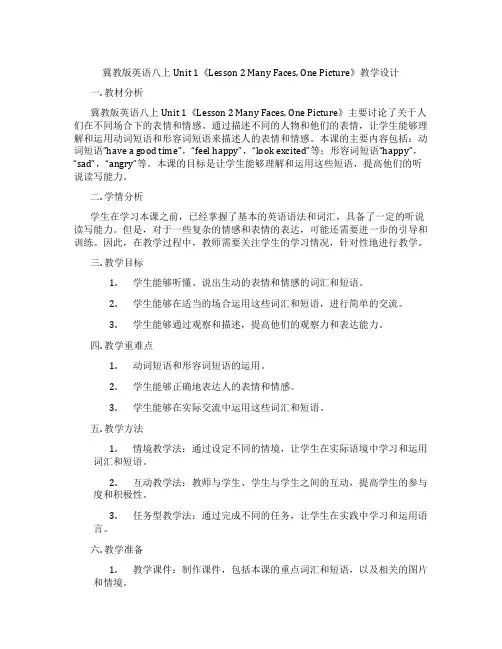
冀教版英语八上Unit 1《Lesson 2 Many Faces, One Picture》教学设计一. 教材分析冀教版英语八上Unit 1《Lesson 2 Many Faces, One Picture》主要讨论了关于人们在不同场合下的表情和情感。
通过描述不同的人物和他们的表情,让学生能够理解和运用动词短语和形容词短语来描述人的表情和情感。
本课的主要内容包括:动词短语“have a good time”,“feel happy”,“look excited”等;形容词短语“happy”,“sad”,“angry”等。
本课的目标是让学生能够理解和运用这些短语,提高他们的听说读写能力。
二. 学情分析学生在学习本课之前,已经掌握了基本的英语语法和词汇,具备了一定的听说读写能力。
但是,对于一些复杂的情感和表情的表达,可能还需要进一步的引导和训练。
因此,在教学过程中,教师需要关注学生的学习情况,针对性地进行教学。
三. 教学目标1.学生能够听懂、说出生动的表情和情感的词汇和短语。
2.学生能够在适当的场合运用这些词汇和短语,进行简单的交流。
3.学生能够通过观察和描述,提高他们的观察力和表达能力。
四. 教学重难点1.动词短语和形容词短语的运用。
2.学生能够正确地表达人的表情和情感。
3.学生能够在实际交流中运用这些词汇和短语。
五. 教学方法1.情境教学法:通过设定不同的情境,让学生在实际语境中学习和运用词汇和短语。
2.互动教学法:教师与学生、学生与学生之间的互动,提高学生的参与度和积极性。
3.任务型教学法:通过完成不同的任务,让学生在实践中学习和运用语言。
六. 教学准备1.教学课件:制作课件,包括本课的重点词汇和短语,以及相关的图片和情境。
2.教学素材:准备一些关于表情和情感的图片,用于引导学生进行观察和描述。
3.教学设备:准备投影仪和音响设备,用于展示课件和播放音频材料。
七. 教学过程1.导入(5分钟)通过播放一段关于人们表情的视频,引导学生关注人们的表情和情感。
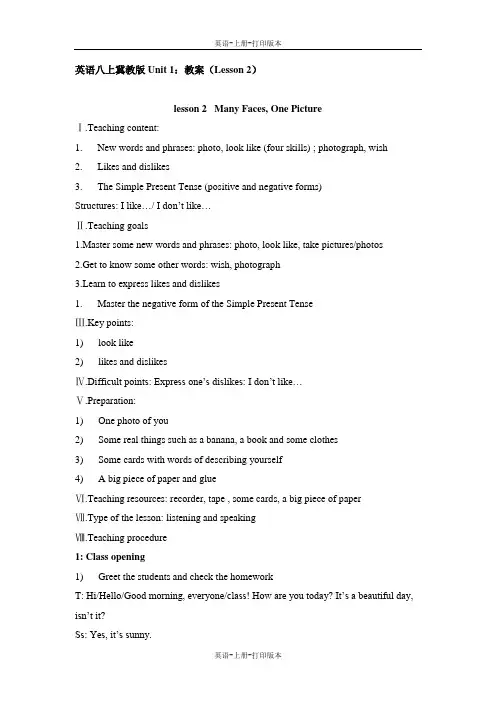
英语八上冀教版Unit 1:教案(Lesson 2)lesson 2 Many Faces, One PictureⅠ.Teaching content:1. New words and phrases: photo, look like (four skills) ; photograph, wish2. Likes and dislikes3. The Simple Present Tense (positive and negative forms)Struct ures: I like…/ I don’t like…Ⅱ.Teaching goals1.Master some new words and phrases: photo, look like, take pictures/photos2.Get to know some other words: wish, photograph3.Learn to express likes and dislikes1. Master the negative form of the Simple Present TenseⅢ.Key points:1) look like2) likes and dislikesⅣ.Difficult points: Express one’s dislikes: I don’t like…Ⅴ.Preparation:1) One photo of you2) Some real things such as a banana, a book and some clothes3) Some cards with words of describing yourself4) A big piece of paper and glueⅥ.Teaching resources: recorder, tape , some cards, a big piece of paperⅦ.Type of the lesson: listening and speakingⅧ.Teaching procedure1: Class opening1) Greet the students and check the homeworkT: Hi/Hello/Good morning, everyone/class! How are you today? It’s a beautiful day, isn’t it?Ss: Yes, it’s sunny.T: Ok, Let me check your homework first.(a few minutes later)2) Prepare for the new lessonT: let’s try to remember what we learned yesterday. We talked about Li Ming’s school. In this lesson, we will talk about something new.(Take out the banana, book and a piece of clothes of the bag)T: Can anyone guess why I have brought these things? What is the connection between th ese things? Please guess. Look, this is my red blouse, I’ve told you I like red very much. And the book, it’s my birthday present last year. Yes, this is a banana.I often buy bananas because I like eating bananas.Ss: You like all of them!T: Very good, you got it!2. New lessonStep 1: lead in(Show the three things )T: These are the things I like best. Next I want to know more about you.Step 2: Discussion before the new lessonT: Look at the questions in “Think About It!” and discuss about them.(introduce the questions to the Ss and give them five minutes to discuss)T: All right! Time for me to know how well you know about your friends. S1, who is your best friend?S1: Wang Gang.T: What do you know about him?S1: He likes basketball very much.T: What about you, S2?S2: My best friend is my cousin, she likes school.T: Good! S3, talk about the favourite photo of yourself, please. When was it taken? S3: Just in the summer holiday.T: Good! What about you, S4? When was your favourite photo taken? And where? S4: It was taken in Beijing last year. My father took the photo for me.Step 3: Discussion about the picture in the textbookT: Look at the picture in your books and let’s talk about it: what is in the girl’s hands? What is she doing?(introduce the word “wish” to the students and make sure they know the meaning of “photo”)Step 4: Further discussionAsk about the title of this lesson: Why is the lesson called “Many faces, One picture?” Step 5: listen and find the answerAsk the Ss to listen to the tape and find the right answer; the answer is in the text. Check the answer with the Ss:Answer: Everyone brings a photo of him or her. We put them together and make a big picture of our class. There are many faces of the students in the big picture.Step 6: Project 1: Make a class pictureMake sure the Ss understand what they must do in the project. Explain what a collage is. (in Chinese if necessary) A collage is a picture made of many little pictures.T: Draw a picture of yourself if you don’t have a photo. Write down at least three sentences about yourself on a small piece of paper. That’s your name card. Of course, our cards are better.(After a few minutes, Ask several Ss a few questions to help them describe themselves.) The questions can go like this:1. What is your name?2. How old are you?3. How tall are you?4. What are you wearing in your picture or photograph?5. What do you like to do?6. Where do you live?(The class will make a collage.T: First, work in pairs please! Ask your deskmate questions about themselves. Then ask other members in your group similar questions.(Let the Ss find their own partner to practise. Using the sentences in their cards. Encourage the Ss to read what they have written down. Then use their own words.) T: Now, it’s the time for us to introduce your partners to out class now. S5, introduce your classmates, please.(After the Ss’ introductions, ask them to glue the pictures to a big sheet of paper for the whole class. Several Ss can glue at the same time.)At the end, the class has a collage! Post the collage in the classroom or the halfway for everyone to see.Step 7: Homework1) Read the text in Lesson 2Do the remaining exercises in the activity book。
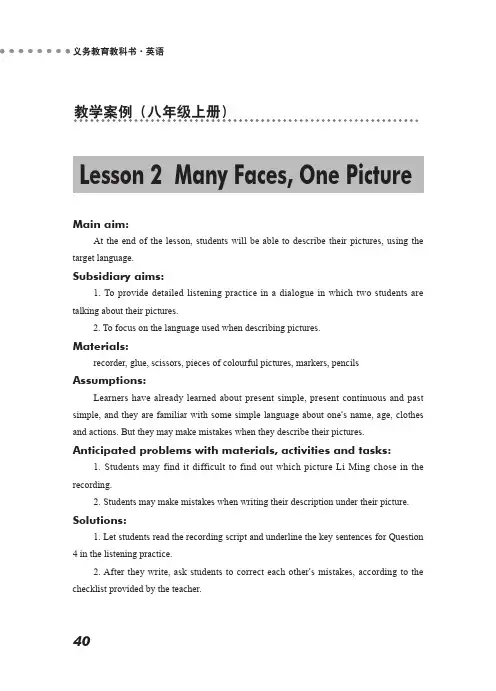
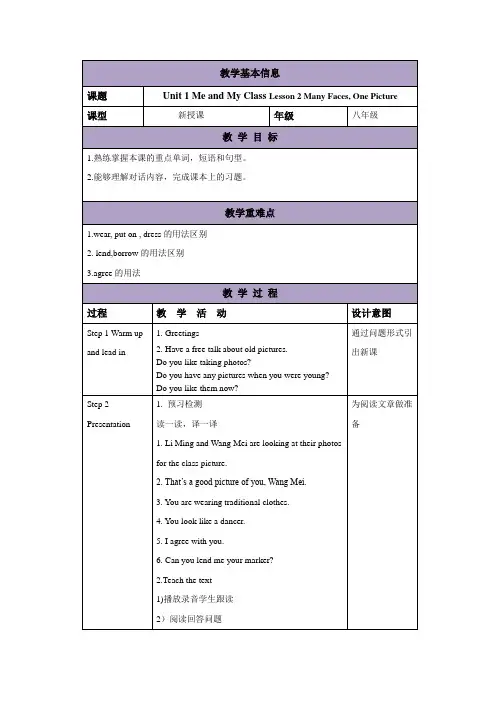
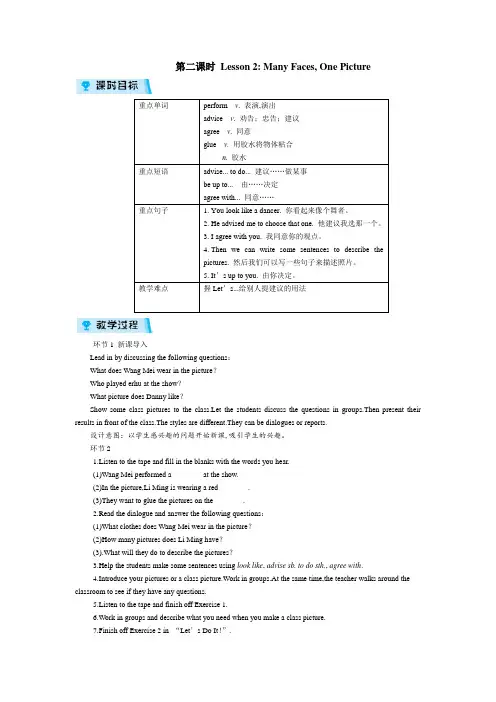
第二课时Lesson 2: Many Faces, One Picture重点单词perform v.表演,演出advice v.劝告;忠告;建议agree v. 同意glue v.用胶水将物体粘合n.胶水重点短语advise... to do... 建议……做某事be up to... 由……决定agree with... 同意……重点句子 1.You look like a dancer. 你看起来像个舞者。
2.He advised me to choose that one. 他建议我选那一个。
3.I agree with you. 我同意你的观点。
4.Then we can write some sentences to describe thepictures. 然后我们可以写一些句子来描述照片。
5.It’s up to you. 由你决定。
教学难点握Let’s...给别人提建议的用法环节1 新课导入Lead in by discussing the following questions:What does Wang Mei wear in the picture?Who played erhu at the show?What picture does Danny like?Show some class pictures to the class.Let the students discuss the questions in groups.Then present their results in front of the class.The styles are different.They can be dialogues or reports.设计意图:以学生感兴趣的问题开始新课,吸引学生的兴趣。
环节21.Listen to the tape and fill in the blanks with the words you hear.(1)Wang Mei performed a________ at the show.(2)In the picture,Li Ming is wearing a red________.(3)They want to glue the pictures on the________.2.Read the dialogue and answer the following questions:(1)What clothes does Wang Mei wear in the picture?(2)How many pictures does Li Ming have?(3).What will they do to describe the pictures?3.Help the students make some sentences using look like, advise sb. to do sth., agree with.4.Introduce your pictures or a class picture.Work in groups.At the same time,the teacher walks around the classroom to see if they have any questions.5.Listen to the tape and finish off Exercise 1.6.Work in groups and describe what you need when you make a class picture.7.Finish off Exercise 2 in “Let’s Do It!”.8.Make a class picture by yourselves by yourself.9.要点点拨。
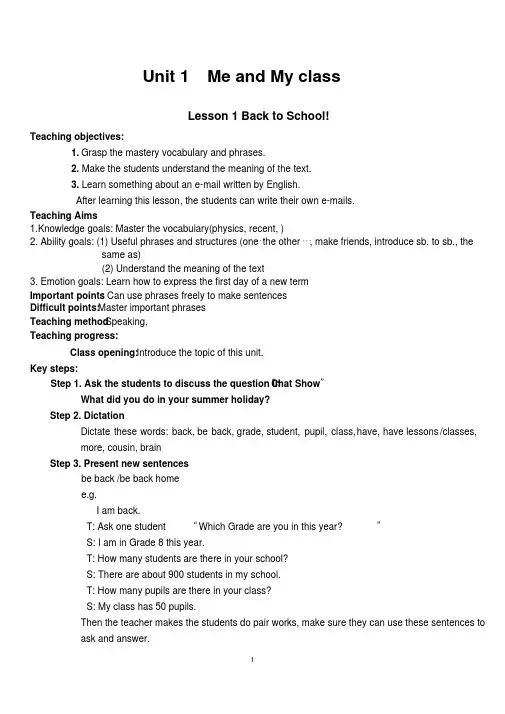
Unit 1 Me and My classLesson 1 Back to School!Teaching objectives:1. Grasp the mastery vocabulary and phrases.2. Make the students understand the meaning of the text.3. Learn something about an e-mail written by English.After learning this lesson, the students can write their own e-mails.Teaching Aims1.Knowledge goals: Master the vocabulary(physics, recent, )2. Ability goals: (1) Useful phrases and structures (one…the other…, make friends, introduce sb. to sb., thesame as)(2) Understand the meaning of the text3. Emotion goals: Learn how to express the first day of a new termImportant points: Can use phrases freely to make sentencesDifficult points: Master important phrasesTeaching method:Speaking,Teaching progress:Class opening: Introduce the topic of this unit.Key steps:Step 1. Ask the students to discuss the question in“Chat Show”What did you do in your summer holiday?Step 2. DictationDictate these words: back, be back, grade, student, pupil, class, have, have lessons /classes,more, cousin, brainStep 3. Present new sentencesbe back /be back homee.g.I am back.T: Ask one student “Which Grade are you in this year?”S: I am in Grade 8 this year.T: How many students are there in your school?S: There are about 900 students in my school.T: How many pupils are there in your class?S: My class has 50 pupils.Then the teacher makes the students do pair works, make sure they can use these sentences toask and answer.Write “We have our class in one room and the teacher s come to us.” Explain the meaning of this sentence to the students.Step 4. Project some questions on the big screen1. How many new classmates does Danny have? What are their names?2. What advice does Li Ming give Danny on how to start a conversation with Sandra?3. Li Ming has a new subject this year. What is it?4. What will Li Ming do to prepare for his class tomorrow? Why?Step 5.Project some sentences o f the second e-mail, have the students listen to the tape and decide them “True” or “False”-mail from China. ( )1. It wasn’t fun to get an e2. This year, school begins at 8:30. ( )3. Every teacher has a different classroom. ( )4. My cousin Brain arrives from the U.K on Tuesday. ( )5. Brain is fourteen years old. ( )Then tell the students the ways to write and send an e-mail.Step 6. Language points.1. Back to school. 返回学校。
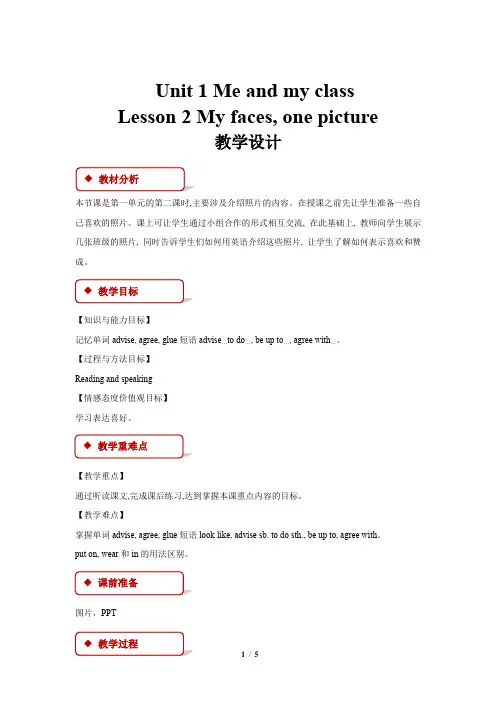
Unit 1 Me and my classLesson 2 My faces, one picture教学设计◆教材分析本节课是第一单元的第二课时,主要涉及介绍照片的内容。
在授课之前先让学生准备一些自己喜欢的照片。
课上可让学生通过小组合作的形式相互交流, 在此基础上, 教师向学生展示几张班级的照片, 同时告诉学生们如何用英语介绍这些照片, 让学生了解如何表示喜欢和赞成。
◆教学目标【知识与能力目标】记忆单词advise, agree, glue短语advise…to do…, be up to…, agree with…。
【过程与方法目标】Reading and speaking【情感态度价值观目标】学习表达喜好。
◆教学重难点◆【教学重点】通过听读课文,完成课后练习,达到掌握本课重点内容的目标。
【教学难点】掌握单词advise, agree, glue短语look like, advise sb. to do sth., be up to, agree with。
put on, wear和in的用法区别。
◆课前准备◆图片,PPT◆教学过程Step Ⅰ. Lead inLeading in 【情景1】Good morning/afternoon, everyone. Welcome to our second day of school. How are you today? Who can tell me what the date is today?Danny and Li Ming talked about their first day of school in the last lesson. Danny had two new classmates Mary and Sandra. Li Ming would prepare a picture of himself for the class picture. What picture would Li Ming choose? Let’s see.[设计意图]用复习的形式导入新课,既复习了上节课的内容,又设置了疑问,学生可以带着这个问题学习新课,找到答案。
Lesson 2: Many Faces, One Picture◆课程导航【教学目标】1. 了解一般现在时的否定句及其构成形式2. 通过谈论班级挂图上的图片,让英语贴近同学们的生活3.用一般现在时态描述一下自己【教学重点】1. New words and phrases of the section.2. Expressing likes and dislikes.3. Master the negative form of the Simple Present Tense.【教学难点】1. Know about the structures of the text. I like…/ I don’t like…2. Introduce yourself or describe other people.3. Help your students get to know one another better.◆教学情景导入Hi, class! Look, this is my photograph. I write some sentences about me on it. Do you have lots of new ones? I think so . Ok, I have an idea. Let’s make a class picture. There are many faces, but one picture.◆教学过程设计Step 1. Greet the students and check the homework. Let me check your homework first.For a few minutes later.Step 2. Show some things to the class.T: They are the things I like best. Next I want to know more about you.S: ……Step 3. Discussion. Look at the qu estions in “Think About It!” Let’s discuss about them.First let me introduce the questions to you. You have five minutes to discuss them.Step 4. Play the audiotape. Have the class follow the audiotape while looking at the text with the question . And then let the students to answer.T: Why is the lesson called “Many faces, One picture?”S: ……Step 5. Talk about the picture in the textbook. Look at the picture in your books and let’s talk about it: what is in the girl’s hands? What is she doing? i ntroduce the word “wish” to the students and make sure they know the me aning of “photo”.Step 6. Come to “Project 1.” Let’s make a class picture . Make the students understand what they must do to complete the project . Draw a picture of yourself if you don’t have a photo. Write down at least three sentences about yourself on a small piece of paper. That’s your name card. Of course, our cards arebetter. After a few minutes, Ask several students a few questions to help them describe themselves.The questions can go like this:T: What is your name? S: ……T: How old are you? S: ……T: How tall are you? S: ……T: What are you wearing in your picture or photograph? S: ……T: What do you like to do? S: ……T: Where do you live? S: ……Step 7. Homework. Ask your partner questions about him or her. And then introduce her/him out in front of the class.◆课堂板书设计Lesson 2: Many Faces, One Pictureslike photo=photograph wishbring sth. to + some placetake sth. to + some placewrite … about …a piece of paper two pieces of paper some pieces of meatglue sth. to + some placehope to do sth.hope that …wish to do sth.wish sb. to sth.wish that … (Use the past tense verb)look like◆作业1. Finish the remaining exercises in the activity book.2. Preview the next reading in the student book.3. Write a paragraph on your favourite person in your family.●教学反思在教学过程中,注重与学生沟通,让学生消除对英语学习的恐惧感,只有对英语感兴趣,才能保持英语学习的动力并取得好成绩。
第二课时Lesson 2It's Getting Warmer!课时目标
一、用所给词的适当形式填空。
1.The sun rises (rise ) at six this morning.
2.Did you know lightning is some times hotter (hot) than the sun?
3.When he grew up,he became (become) a doctor.
4.The snow doesn't melt (not melt) easily in winter.
5.Can you tell the difference (different) between them?
二、写出下列画线短语的汉语意思。
1.I need neither my heavy winter coat nor my boots now!既不……也不……2.On my way to school this morning,I saw some winter jasmine blossoming.迎春花
3.Children run around or play_on_the_swings.荡秋千
4.My class is also planning a_field_trip to the countryside.野外旅游;远足;(学生)实地考察旅行
教学过程
环节1新课导入
T:What is spring weather like?
S1:In spring,the weather becomes warmer.The temperature goes up!
S2:In early spring,it sometimes snows.But the snow melts quickly because of the warm sunshine.
S3:In April,showers begin.Sometimes there are storms with thunder and lightning.
T:Which season is your favourite?And why?
Ss:Spring/Summer/Autumn/Winter.Because...
T:OK! Today we will learn more information about spring.
设计意图:通过教师提问、学生回答的形式谈论春天的天气以及学生喜欢的季节,可以激发学生的兴趣,循序渐进地引入本课时的话题。
同时,活跃的课堂氛围为接下来的学习作了铺垫。
环节2新课学习
1.将学生分成若干小组,选出组长,然后一起讨论教材第4页上方“THINK ABOUT IT”中的问题。
2.教师邀请每个小组的组长展示小组讨论后所得的结果,并对学生表述有误的地方予以指正。
3.让学生快速阅读教材中本课时的书信,了解其主旨大意。
4.教师播放课文的录音,让学生模仿录音的语音语调小声进行跟读;然后学生在文中标记出本课时的生词、重要短语以及句子。
5.教师讲解本课时的主要内容。
在讲解的过程中可邀请学生尝试翻译其中的重难句。
6.让学生根据书信内容,完成活动1和活动2的练习。
教师请学生分享答案,然后订正答案。
7.让学生浏览一遍活动3方框中的单词并知道其意思,然后用这些单词完成活动3中的五个句子。
8.教师请五名学生分别读一读这五个句子,全班一起核对答案。
9.学生四至五人为一组进行讨论。
学生可根据活动2和活动3的内容讨论春天及其相关的户外活动。
10.教师邀请三个小组各派出一名代表分享本组讨论后的结果,教师予以点评。
11.要点点拨。
(1)I need neither my heavy winter coat nor my boots now!
①neither...nor...表示“既不……也不……”。
表否定含义,在句中连接任意两个并列的成分。
例:She likes neither butter nor cheese.她既不喜欢黄油也不喜欢奶酪。
【拓展】当neither...nor...连接两个主语时,其后的谓语动词应遵循“就近原则”。
neither作主语单独使用时,表示“两者中没有一个”。
例:Neither dad nor mum is at home today.今天父母都不在家。
②neither...nor...句型变为肯定句,可将neither...nor...改为both...and...
【注意】both...and...结构中,谓语动词必须用复数形式。
例:Both dad and mum are at home today.今天父母都在家。
③当表达一个人没有做某事,另一个人也没做同一件事时,可用neither或nor进行简略回答,其结构为:Neither/Nor+助动词/情态动词/be动词+主语.
(2)Every morning,I see lots of people exercising in the park.
see sb.doing sth.看见某人正在做某事。
例:I saw her chatting with her neighbors when I walked past her room.我经过她房间的时候,看到她正和邻居聊天。
12.学以致用。
(单项选择)
(C)(1)When I ran to the bus stop,I saw an old lady ________ under the tree.
A.wait B.waited
C.waiting D.are waiting
(B)(2)I have two sisters,but ________ of them is a teacher.
A.all B.neither
C.both D.none
(D)(3)—Which do you prefer,a smart phone or a model plane?
—________.I prefer a portable computer.
A.Both B.Either
C.None D.Neither
设计意图:通过让学生分组讨论和结对练习既可以促进学生之间的交流合作,又能培养学生的口语表达能力;通过学习有关春天的相关知识,了解一些户外活动,可以让学生有效地将学习与日常生活相结合,达到趣味学习的效果。
板书设计
请完成本课对应训练!。